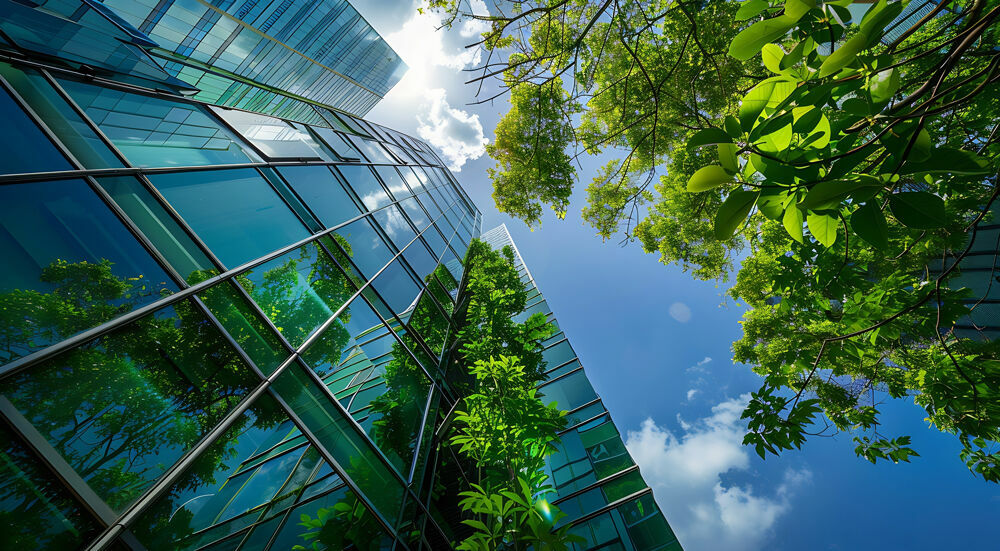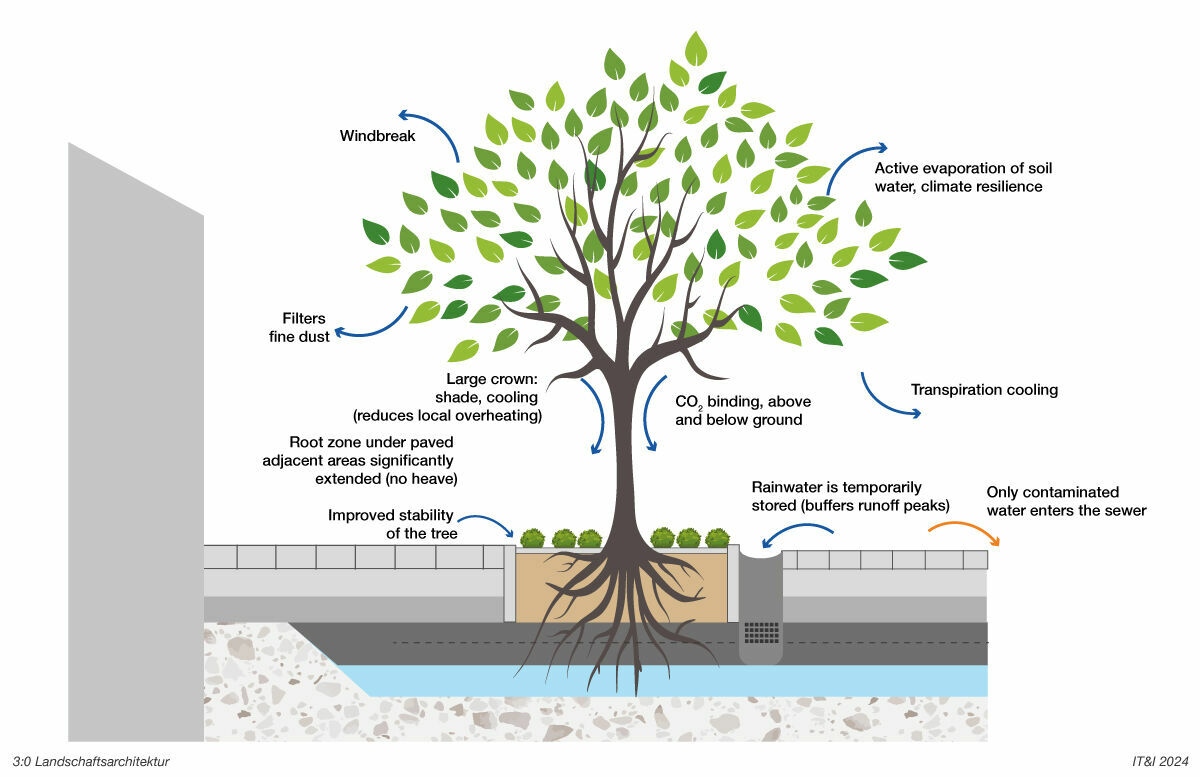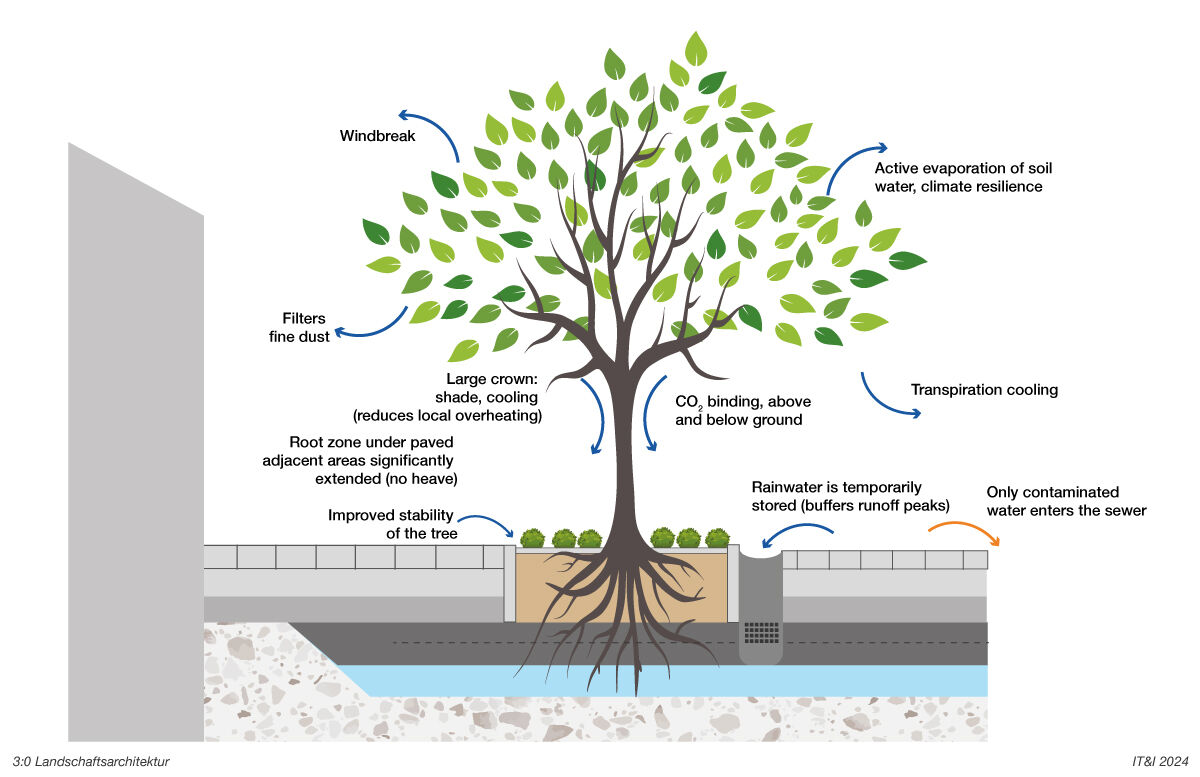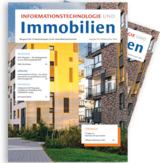The future of urban planning – the sponge city

Urban city planning is increasingly incorporating the effects of a sponge city. The aim is to return cities to something approaching the natural water cycle. But what exactly is a sponge city? With this concept, the city stores water and then releases it in a controlled manner. The idea is for rainwater to be absorbed locally as the city “soaks it up like a sponge” with the help of various measures. Plans vary from measures on the building and the neighbouring land to neighbourhood-based plans. They include a combination of rainwater retention, unsealing, decoupling, infiltration, evaporation and planting.[2]
Sustainable rainwater management
Modern rainwater management is becoming increasingly important for urban planners and local authorities. In order to prevent flooding and overloading of the sewage system, areas can be created that are capable of absorbing large quantities of water and releasing it back into the sewage system with a time delay. Such surfaces ensure that rainwater is effectively retained and released in a controlled manner. The aim is to collect rainwater where it occurs, as far as possible, and feed it back into the rainwater cycle – in line with the principle of decentralised rainwater management. This means that water is processed directly on site instead of being drained off quickly. It is purified by natural processes such as seepage and filtration in the soil. These processes enable pollutants to be removed and the purified water then enriches the groundwater.
So the soil purifies the water and, ultimately, the water enriches the groundwater. Only through the interplay of various green measures such as green roofs and façades, permeable paving and drainage troughs can water-sensitive urban development become particularly efficient. An integral part of the concept is the unsealing of surfaces. This is the only way to enable water absorption. Unsealing, meaning breaking up sealed surfaces such as asphalt or concrete, allows the soil to absorb water again. The water stored in this way can provide additional cooling during dry periods and prevent the formation of heat islands.
Bearable urban climate for people and nature
Thanks to the unsealing of surfaces, there is more space for new urban trees, which are very important for regulating the summer climate. Thanks to the shade provided by the treetops and the cooling of the surrounding air through evaporation, trees are considered a natural air conditioning system and ensure bearable temperatures. They also store CO2, filter fine dust particles, produce oxygen, and therefore contribute to improved air quality.
A prerequisite for trees’ positive ecosystem services is their vitality, which is only ensured if they are supplied with sufficient air, water and root space. This is not always the case in sealed cities. The sponge city principle can help here: unsealing, irrigation and the creation of tree infiltration structures – cavities for the roots of trees – give the trees room to grow. The cooling effect of a tree increases as it grows.[3]
Better utilisation of rainwater
With the help of intensive green roofs on houses and garages, up to 100 per cent of annual precipitation can be retained. The greening of façades with climbing plants or “living walls”, in which greenery is planted directly on the façade, contributes to a better microclimate, primarily through evaporative cooling and insulation against heat, cold and wind. Rainwater from the roof can also be stored in collection tanks on the building and used for flushing toilets, cleaning or irrigation, or it can be treated and – with the aid of special technology – also be used for cooling a building.
Rain-permeable floor coverings can be used in common areas. In other areas, extensive infiltration is possible via extensive green areas or, along roads and footpaths, through troughs or infiltration structures. Infiltration trenches are characterised by the fact that they contain a storage body, usually filled with gravel, which absorbs and temporarily stores precipitation in less permeable soils. Special infiltration trenches planted with trees rely primarily on the evaporation capacity of the tree. Excess seepage water is collected here and released to the tree roots with a delay.

Figure 1: Large-crowned trees create flood zones for water.
 Figure 1: Large-crowned trees create flood zones for water. |
Effective rainwater utilisation for climate adaptation
With the increasing challenge of heavier rainfall and climate change, more rainwater cisterns and other storage solutions are becoming necessary. If there is sufficient space, artificial ponds, ditches and rainwater retention basins can also be used. They store purified rainwater in the short or long term and allow it to evaporate.[4] To prevent overflows in the sewer system, underground storage capacities must also be significantly increased. Water can be temporarily stored in underground basins and channels before it is transported to the sewage treatment plant. One exceptional example is the Bassin d’Austerlitz – a gigantic rainwater basin in Paris with a depth of 30 metres and a diameter of 50 metres. It protects the Seine from flooding and pollution. An impressive project, especially in a metropolis as densely populated as Paris.[5]
All these measures have a demonstrably positive effect on the water cycle and the urban climate. By keeping the water localised and promoting evaporation, they reduce heat stress in urban areas. This is particularly important as the temperature in cities is always one to three degrees and at night even up to 12 degrees Celsius higher than in the surrounding area. This “heat island effect” will become increasingly burdensome for the urban population as global warming continues, especially in the summer months. Rapid implementation of the sponge city concept is therefore more urgent than ever for climate change adaptation.[6]
Trees as green retention areas
The sponge city principle also ensures the survival of urban trees in street spaces. It’s an innovative system that enables the healthy development of large-crowned trees on sealed surfaces such as pavements, car parks and roads. The sponge city principle for trees is a construction method and not a building product. It allows tree root zones to lie under paved surfaces (pavements, car parks, roads) without causing damage. To achieve this, the road substructure must have a suitable structure that fulfils both the technical requirements of road construction and the biological requirements of trees. The additional positive effect is the creation of retention areas – flooding areas for rainwater that relieve the sewer system and supply the trees with water even during dry periods.[7]
Conclusion
If the sponge city or rainwater management concept has so many advantages, why hasn’t it been standard everywhere for a long time? This, too, is a question of cost. Building land is expensive and measures to store rainwater require space. When it comes down to it, the measures make a building project significantly more expensive. However, the principle of a sponge city will probably prevail because there are no alternatives. It has many advantages in terms of sustainability. And, above all, it makes urban spaces more liveable – a big plus for everyone.
1/3: “Grün in die Stadt” (Green in the City) initiative by BGL: Schwammstadt. Link (in German): https://www.gruen-in-die-stadt.de/schwammstadt/
2/4/6: BUND-Berlin: Sponge City – Decentralised rainwater management. Link (in German): https://www.bund-berlin.de/themen/stadtnatur/stadtwasser/schwammstadt/
5: Max Frank GmbH & Co. KG (2024): Bassin d’Austerlitz project. Link: https://www.maxfrank.com/uk-en/projects/entries/bassin-dAusterlitz-paris-FR.php
7: Sponge City Working Group (GesnbR): The sponge city principle for trees. Link (in German): https://www.schwammstadt.at/
Author:

Ernst Hubert von Michaelis
Sales Representative
PROMOS consult
Other articles by this author:
- Article "The future of urban planning – the sponge city"
- Article "Urban Mobility – networked transport for the future"
- Article "We need to create additional housing – but how?"
- Article "The metropolis of the future – a discussion article"
- Article "Co-working – Find a workspace and network at the click of a mouse"
- Article "Less is more – an alternative way of living"
- Article "Micro living – the future of living as a new asset class"
- Article "The digitisation of retail – in-store, online, mobile... Wasted opportunities or risks?"
- Article "Accounting for leasing relationships in accordance with the IFRS 16 standard with low administrative expense"
- Article "Working from home is passé... the new trend is working on the move"
- Article "All that is possible with individual mobility"


